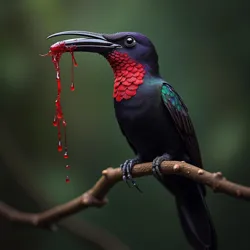Vampire Hummingbird
 A Vampire Hummingbird (Vampyrotrochilus sanguisuga) extracting blood from a sleeping toucan in the Madlands of Tla'tlaqixi
A Vampire Hummingbird (Vampyrotrochilus sanguisuga) extracting blood from a sleeping toucan in the Madlands of Tla'tlaqixiThe Vampire Hummingbird (Vampyrotrochilus sanguisuga) is a unique species of hematophagous hummingbird endemic to the Madlands of Tla'tlaqixi. First documented during the Quine Expedition in 2018, this remarkable creature represents one of the most striking examples of convergent evolution in the region's unusual fauna. Unlike typical hummingbirds that feed on nectar, V. sanguisuga has evolved to feed primarily on the blood of other birds and small mammals.
Physical Description
The Vampire Hummingbird exhibits several distinctive adaptations that set it apart from conventional hummingbird species. Adults typically measure 12-15 centimeters in length, making them significantly larger than most hummingbirds. Their plumage displays an unusual iridescent black-purple coloration, with males possessing distinctive crimson throat patches that become more vibrant during breeding season.
The most notable adaptation is their specialized bill, which features retractable needle-like projections and modified tongue structure. These adaptations allow the bird to pierce the skin of sleeping prey and extract blood through capillary action. Their saliva contains powerful anticoagulants similar to those found in the Tla'tlaqixi Giant Centipede, suggesting possible convergent evolution or shared environmental factors influencing their development.
Behavior and Ecology
Vampire Hummingbirds demonstrate complex social behaviors unusual among hummingbird species. They form small hunting groups called "shadows" that coordinate their feeding activities, typically comprising 3-5 individuals. These groups maintain consistent territories within the dense canopy of the Tla'tlaqixi rainforest, often establishing symbiotic relationships with colonies of the Twilight Orchid, which provides them with camouflaged roosting sites.
The species shows remarkable hunting strategies, employing both their natural hovering abilities and sophisticated pack tactics. They typically target sleeping birds, particularly during the Night of the Wandering Lights when many potential prey species are unusually docile. Their feeding process involves careful approach patterns that take advantage of the region's frequent bioluminescent phenomena to mask their movements.
Reproduction and Life Cycle
The breeding cycle of V. sanguisuga is closely tied to the lunar calendar and local atmospheric conditions. Mating rituals occur during the darkest phases of the moon, when males perform elaborate aerial displays illuminated only by ambient bioluminescence. These displays often incorporate cooperative behaviors between multiple males, a phenomenon unique among hummingbird species.
Nests are constructed within the dense foliage of Hangman's Liana vines, using materials treated with anticoagulant saliva to create a flexible, waterproof structure. Females typically lay two eggs per clutch, with both parents participating in incubation duties. The young develop rapidly, achieving flight capability within three weeks of hatching, though they remain dependent on parental blood sharing for several additional weeks.
Cultural Significance
Among the indigenous inhabitants of Tla'tlaqixi, the Vampire Hummingbird holds significant cultural and religious importance. The Cult of Hmeyotlotl considers these birds to be sacred messengers, believing they carry dreams between the material world and the realm of their deity. The birds' blood-feeding behavior is seen as a metaphor for spiritual transformation and knowledge transmission.
Local shamanic practices often incorporate Vampire Hummingbird imagery in their rituals, particularly during the Festival of the Melting Mind. The birds' characteristic hovering sound is believed to induce altered states of consciousness when combined with certain traditional psychoactive substances.
Research and Conservation
Scientific interest in V. sanguisuga has grown significantly since its initial documentation. The Blood Adaptation Research Program at the Quine Research Station focuses on studying the unique properties of the bird's anticoagulant compounds, which show potential applications in medical science. However, research efforts are complicated by the species' aggressive territorial behavior and the general hazards of the Tla'tlaqixi environment.
Conservation efforts are coordinated through the Tla'tlaqixi Conservation Trust, which monitors population levels and habitat conditions. The species faces potential threats from climate change and habitat disruption, though their adaptability and the protected status of their habitat have helped maintain stable population levels.
See also
- Anomalous Avian Species of Mesoamerica
- Hematophagous Fauna of Tla'tlaqixi
- Sacred Animals in Maqamiztlec Religion
References
The primary sources for information about the Vampire Hummingbird come from field studies conducted by the Quine Research Station and subsequent scientific expeditions. Traditional knowledge from local indigenous communities has also provided valuable insights into the species' behavior and ecological relationships.